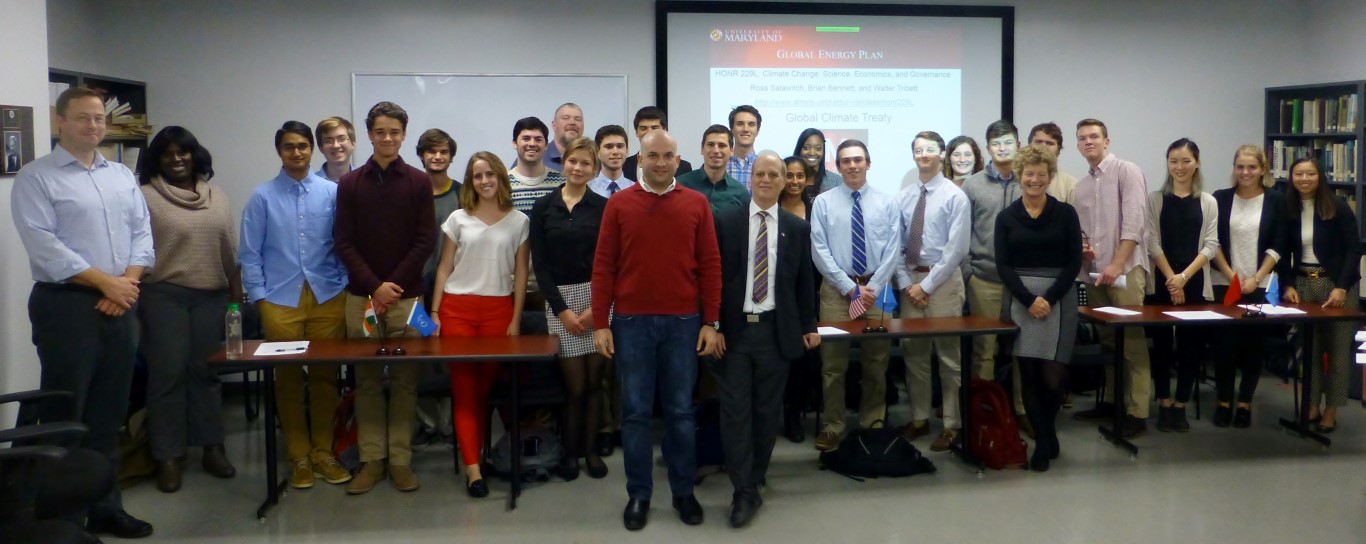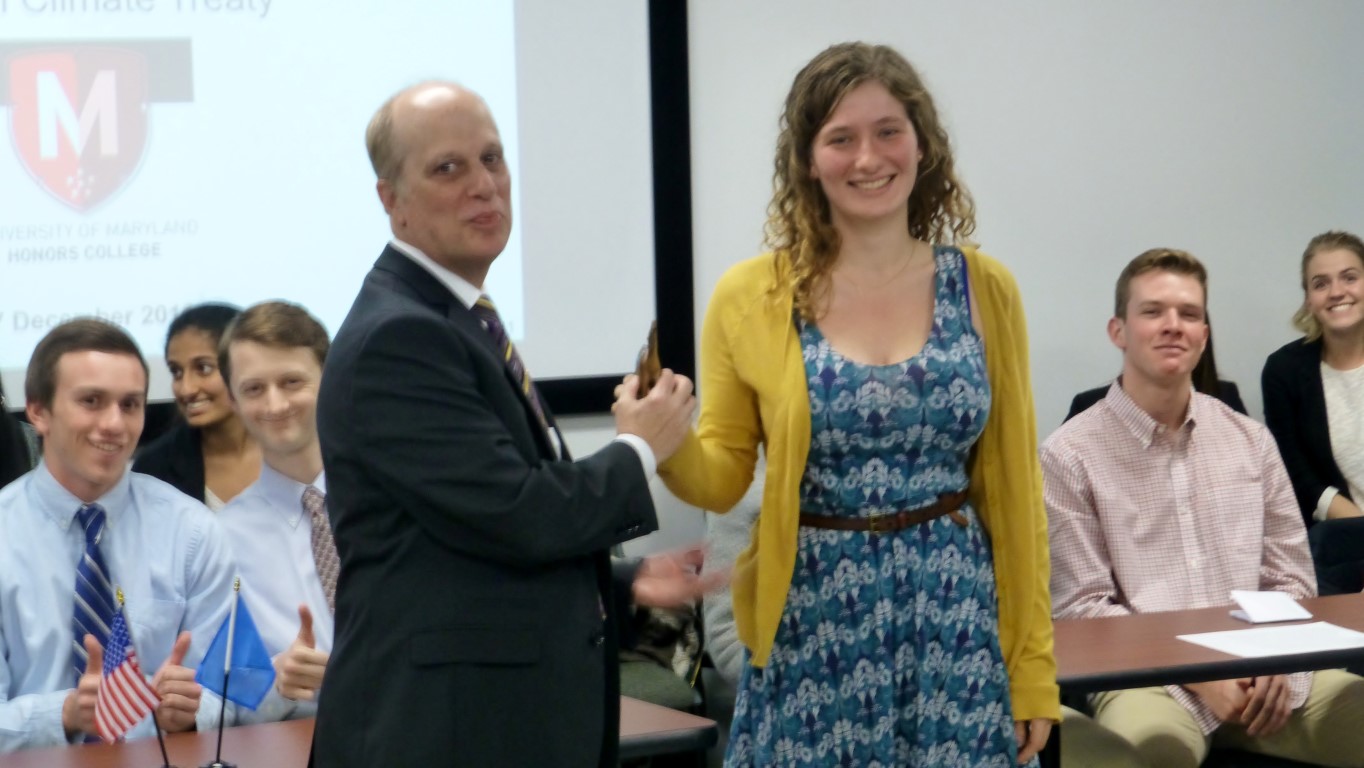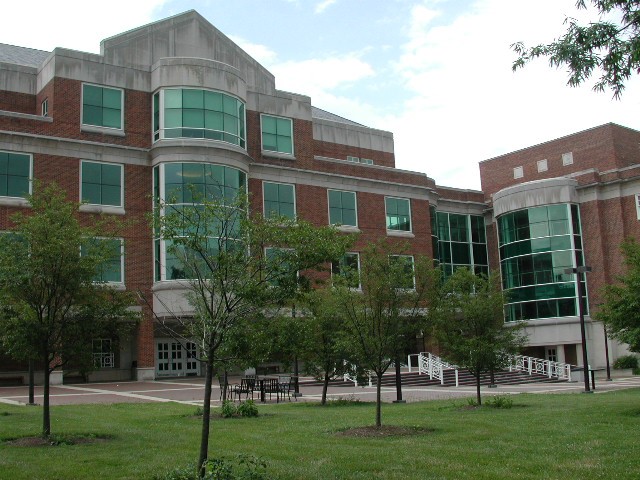HONR 229: The Science,
Economics, and Governance of Climate Change
AOSC 433/633 & CHEM 433/633: Atmospheric Chemistry and Climate
AOSC 652: Numerical Methods in Atmospheric and Oceanic Science
HONR 229L
examines issues related to the science, economics, and governance of
climate change from the perspective of a social scientist: i.e.,
this class is heavy on reading and writing and hardly uses
any equations. The class is part of the
UMd
Honors College program and has also been selected as an
I-series course. Students interested in enrolling are encouraged
to read the
description for HONR 229L on the Honors College webpage and
speak to other students who have taken the
class, via networking in the Honors College.
A
hallmark of HONR 299L is at the end of the semester, the class
breaks into three groups and completes an interactive project, with
every student assuming a role that mimics a real-life counterpart.
During the first year, the students negotiated a Global Climate
Agreement: at the same time the
meeting that lead to the Paris
Climate Accord was being held! During the second year,
students negotiated how the goal of the Paris Climate Accord, which
is to limit global warming to no more than 2°C above pre-industrial, would be met: at the same time the
COP 22 meeting in Marrakech, Morocco was held. During
Years 1 and 2, we were able to provide an amazing course enrichment
because the person assisting with the teaching of the class, Walt Tribett and Brian Bennett,
actually attended the meetings in Paris and Marrakech and posted regular
updates for the class.

HONRS
229L 2016. Students pictured along with the instructor (yours
truly), Tim Canty, Akua Asa-Awuku, and Safa Motesharrei who judged
the final project that was won by Team China, Brian Bennett and Walt
Tribett who helped with various aspects of the class, and Susan
Dwyer,
Executive Director of the Honors College, during the final
public presentation that was attended by about 40 members of the
community.

Julianna
is pictured being presented the grand prize, a wooden carving of a
camel brought back from Marrakech, Morocco by Brian Bennett, who had
attended the COP22 meeting. Julianna was the negotiator for
Team China, whose presentation was selected "best" by our panel of
judges. I had asked each team to give me a sealed envelope
with the name of one person who would get the wooden camel, should
their team's presentation for achievement of the Paris INDC be
deemed best by the panel of judges. Julianna was genuinely
surprised because Team China had placed her name in the envelope
when she was outside of the room, participating in a negotiating
session. Appreciate the "signs of approval" from Team USA.
Despite being obscured in the photo, the camel carving actually has
exquisite detail. Having an announced "prize" led to an element of
competition among the three teams regarding who would arrive at the
best plan for reducing future emissions of greenhouse gases.
I hope to provide an equally fulfilling class project
for Year 3.
_____
AOSC
433/633 & CHEM 433/633 focuses
on global warming, the carbon cycle, air pollution, and the ozone layer.
Fundamentals of atmospheric chemistry are related to the modern
understanding of these topics based on resources such as satellite
missions, field campaigns, and scientific assessments published by
international agencies. We also examine how society’s energy needs could
be met, in the future, in a manner with less impact on atmospheric
composition than the present heavy reliance on combustion of fossil fuels.
This class is typically taught in the Spring, in a class room that
seats about 40 students. The material is taught at a level
appropriate for upperclass undergraduate chemistry or physical
science majors and first year graduate students: i.e., this class
relies on equations, has numerous problem sets, etc.
Undergraduates are encouraged to enroll in the appropriate 400-level
offering unless there is a compelling reason to place a 600-level
class on your transcript; students enrolled at the 600-level have
extra, more challenging questions on the problem sets and take more
difficult exams. Undergrads must obtain instructor permission
to enroll in the 600-level offering.
_____
AOSC 652
is a numerical methods course taught in a computer lab featuring modern Linux work stations. This class is designed for
incoming graduate students and advanced undergraduates who have limited or
no prior computational experience in a Unix or Linux environment. We cover numerical
techniques often used in modern atmospheric and oceanic science via many
hands-on exercises involving FORTRAN,
MATLAB,
and IDL, the tools of our trade. These exercises involve use of
real data of widespread interest, such as the Vostok ice core record and
the modern global mean temperature anomaly. A new addition to the
class is the use of the Python programming language. This class is typically
taught in the Fall, in a computer lab that has about 25 seats.
AOSC 652 has been taught for many years by Ross Salawitch with help
from Tim Canty. During Fall 2017, the class will be
taught for the first time by
Jeff Henrikson, the AOSC IT
manager.
Please
contact me if you have questions about any of these courses.




